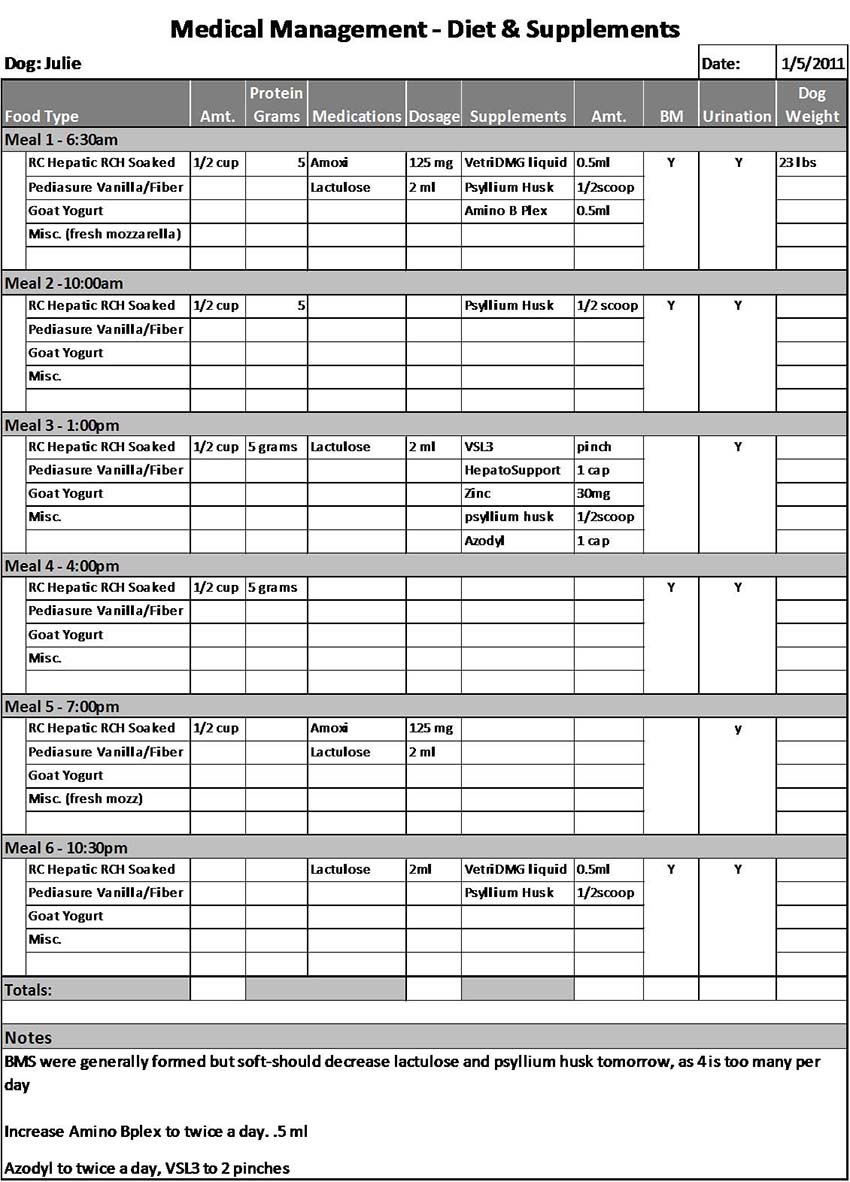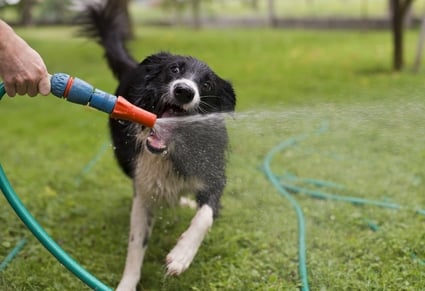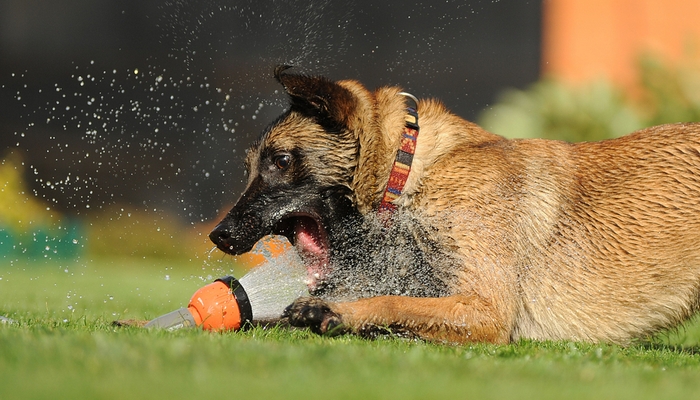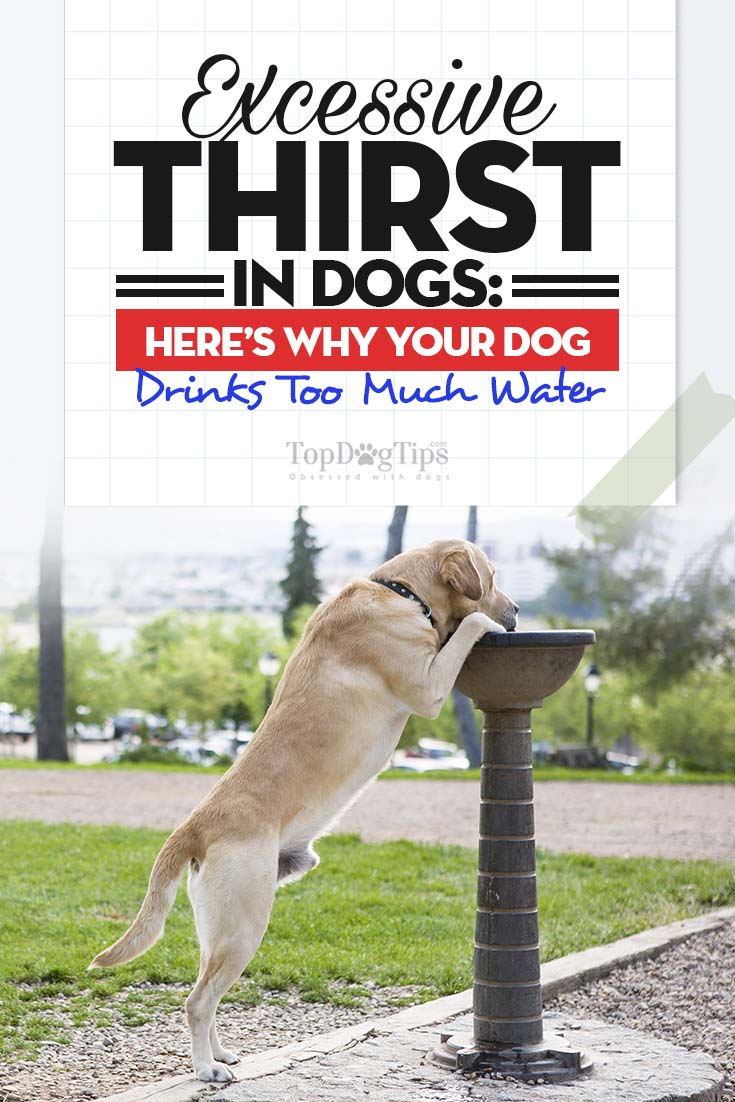Table of Contents
Have you noticed your dog drinking more water than usual? This may be just temporary or a sign of illness. Dogs' excessive thirst becomes a concern when they ingest an entire dish and are looking for more.
Watch for these symptoms, and notify your vet if they continue for more than 24 hours:
- you have to refill your pet's water bowl much too often;
- a dog starts drinking from the toilet or searches other places to get a drink;
- your dog asks to go outside far more than usual;
- a dog drinks so fast they vomit the water back out;
- you notice a dog peeing more than usual or having accidents in the house.
Keep track of your dog's water consumption during the day.

8 Causes of Excessive Thirst in Dogs (Polydipsia)
In dogs, excessive urination and excessive thirst are medically known as Polydipsia, defined as a water intake of over 100 ml/kg/day.
It can be either primary or secondary in its origin (1, 2). This is a common condition, and Polydipsia in dogs can have many underlying causes (3, 4).
Depending on the culprit, a vet will run tests to rule out symptoms one at a time, and sometimes this may become a long process.
1. Kidney Problems
Malfunction of a dog's kidneys is when the kidneys fail to remove toxins from the bloodstream.
The average water balance in your dog's body becomes disturbed (5, 6). Kidney failure is the next stage, which becomes a significant health issue, and it can even be fatal.
Kidney disease in dogs has to be treated immediately. There are two most common ways dogs develop kidney disease: (a) an existing health problem (b) an injury, such as being hit by a car.
Early signs of this condition are excessive thirst and excessive urination in dogs. As their kidneys get worse, a dog will keep drinking more water.
Their kidneys no longer remove poisons the way they should, and more water is needed to do the job.
Contaminated foods and dental disease may also cause kidney problems where the infection is released into the bloodstream (7).
Some medications or related diseases may also contribute to kidney disease and renal failure (8).
Treatment will vary depending on the stage of the disease. A dog is likely to be kept at a clinic for intensive treatment to stabilize the kidneys.
They will use intravenous liquids to reduce the toxins in the body. They may give proper pain management methods and anti-nausea drugs to begin healing.
The disease can be slowed with IV liquids and a low protein diet, decreasing kidneys' workload.
Vets may prescribe blood pressure medication and stomach acid control medications.
Kidney disease in dogs is only slowed down and managed; you cannot cure it. The highest survival times for dogs with kidney disease are up to 4 years.
There will need to be a permanent switch to low-protein dog foods or a low-protein homemade diet explicitly designed for this condition.
2. Diabetes Mellitus
Diabetes is common in overweight dogs, and it also contributes to a wide variety of health problems among pets.
It's a common cause of excessive thirst in dogs and cats (9, 10).
The presence of: diagnoses canine diabetes
- excessive thirst in dogs
- excessive hunger
- excessive urination
- weight fluctuations
- chronically high levels of blood and urine glucose
One of the first symptoms of diabetes in dogs is excessive thirst and urination (11).
Similar to kidney disease, you cannot treat it at home. If you suspect that a dog's excessive thirst is caused by diabetes, consult with a vet immediately.
Once at the clinic, your vet will test the dog's urine for the presence of ketones and glucose.
If the results show the need for further tests, the vet will measure the glucose in the blood.
A diagnosis of diabetes is positive when glucose is in the urine and concentrated in the blood.
Treatment for this form of diabetes is similar to humans: glucose is monitored with the same meters that humans use, a special diabetes diet is designed, exercise is monitored, and insulin may need to be administered.
Fortunately, you can reverse diabetes in dogs with treatments, insulin, and diabetic dog foods.
Your vet or canine nutritionist should recommend you appropriate food brands or help you design a homemade food diet for diabetic dogs (for example, see this recipe and this one).
3. Diabetes Insipidus
Diabetes insipidus is a rare and not well-known metabolic disorder in dogs that affects how water is used by their body (12).
One of its symptoms is preventing a dog's body from holding onto the water instead of passing out too much of it.
Diabetes can be identified by excessive thirst and urination in dogs, very pale urine, and the constant need for more water (13).
Dogs with diabetes insipidus will keep drinking more yet can still get dehydrated fast, then become disoriented as a result.
The imbalance of electrolytes causes this because of the body's inability to conserve water. It is diagnosed through many blood and urine tests.
Diabetes inspipidus is very rare in dogs, and it is sometimes referred to as water diabetes in dogs. It is to be controlled with diet and, sometimes, specific medication.
The medication used for water diabetes in dogs is usually a hormone replacement for the normal one that every dog should have.
Your vet will keep a close watch to ensure treatment is working and adjust medication if needed.
4. Adrenal Hormone Disease
Dogs' excessive thirst may also indicate a problem with your pet's adrenals and several diseases related to your dog's hormones.
The most common examples are Cushing's disease and Addison's disease. They are two opposite types of infection of the same gland.
Both Cushing's and Addison's have very similar symptoms.
The main difference is that Addison's disease makes your dog act severely depressed and lack energy.
Once again, testing at the vet's office is needed to define the disease and formulate a treatment plan.
Studies observed that the common cause is a small tumor in the dog's adrenal glands (14).
Adrenal problems in dogs are usually treated with medication and constant monitoring.
This may involve extensive testing to decipher which disease the dog has in the first place.
5. Liver Disease
Depending on your pet's age, liver disease can cause excessive thirst in dogs, and it's another serious issue that needs immediate treatment (15).
The liver is essential for many life-sustaining functions in all animals.
A vet might diagnose another organ or bodily system that could cause liver disease.
The most common symptoms associated with liver disease in dogs are:
- loss of appetite
- increased thirst/water intake
- vomiting (often intermittent but usually chronic)
- weight loss
- nausea
- depression
- increased frequency of urination
- lethargy
- dehydration
- increased volume of urine output
Research shows that liver disease is generally not a suspect in puppies (16). This condition is usually seen in middle-aged and elderly dogs.
However, if the breed has a history and hereditary liver disease, it may occur even in a younger dog. You can manage this with medication and a liver-friendly diet.
An example of diet and feeding structure for dogs with liver disease:

Ruling out other conditions is the first thing to do because of the extensive testing needed to diagnose liver disease in dogs.
The liver runs the whole body, so when it breaks down, many other systems will begin failing as well, including brain function.
6. Infection
A dog with an infection will often have a fever, and this will cause them to become dehydrated, resulting in unusual and excessive thirst.
This can come from almost any source or even flu-like illnesses that dogs can contract.
The most common types of infection that may cause frequent urination and excessive thirst in dogs are inflammation and infection of the animal's uterus and kidneys (different from kidney disease).
Your veterinarian will quickly find out whether that is the case with a simple test of urinalysis.
7. Electrolyte Imbalance and Disturbance
Electrolyte imbalance and disturbance, also known as Hypophosphatemia, is directly related to your dog's water consumption and can have many different causes (17).
You must notify your vet and tests performed to determine the exact culprit of Hypophosphatemia in dogs.
Most commonly, this condition is due to high calcium and low potassium in a dog's diet. This is often not only a reason for excessive thirst in dogs but also water intoxication.
Symptoms are very similar, and they can happen in conjunction with kidney disease, liver disease, diabetes, and other ailments.
8. Side Effect of Medication
Many drugs will have a side effect that causes a dog's excessive thirst.
This should be self-limiting and stop when the treatment is over, but if you're concerned, notify your veterinarian.
However, when using prescription drugs, a vet will likely warn you about a possible increase in water intake and whether that is something you should worry about or not.
Other Water-drinking Dangers in Dogs
Is there such a thing as a dog drinking too much water?
Yes. It's possible for a dog to drink too much water, and it should be a cause for concern (18).
Excessive thirst in dogs is not only a symptom of a more significant health problem, but it could be much more.
For example, your dog drinking too much water can be a psychological problem or a learned behavior rather than a specific and known physical illness.
These types of compulsive behaviors may end in over-stimulation and failure of the dog's kidneys, which can result in death.
Sometimes, the problem is compulsive behavior, which is treatable with medication and behavior modification.
It would help if you spoke both with your veterinarian and possibly a professional canine behaviorist on how to fix the root of this issue.
Hyponatremia

Hyponatremia (low sodium levels) is a rare but often fatal condition in dogs (19).
Dogs that play in the water for long periods are at the highest risk.
Even a hose or lawn sprinkler can be hazardous for dogs that try to catch spraying water in their mouths and do this for too long.
Hyponatremia in dogs happens when your pet swallows more water than the body can handle.
This dilutes bodily fluids, creating a dangerous electrolyte imbalance. Too much water lowers sodium levels in the fluid outside of cells.
This condition affects blood pressure nerve and muscle function. Because sodium is essential for dogs, when sodium levels drop, the water goes into the cells and swells the cells.
This includes the brain, meaning the central nervous system is affected. This results in water intoxication, which can be deadly.
Water intoxication symptoms include:
- lethargy
- staggering/loss of coordination
- nausea
- bloating
- dilated pupils, glazed eyes
- vomiting
- light gum color
- drooling
- In severe cases: difficulty breathing, loss of consciousness, coma, seizures, and death
Dogs of any size can end up with this illness, but the condition is typically seen in dogs that enjoy a pond or lake and dogs that enjoy retrieving objects thrown in the water.
Sometimes, this can happen after many activities or playing with a sprinkler or hose.
Dogs with the compulsion to play in their water dish are also in danger of water intoxication.
Water intoxication can affect any size or breed of dog. Smaller dogs show symptoms quickly because of their smaller body mass.
Hyponatremia in dogs is treated with IV electrolytes, diuretics, and drugs to reduce swelling in the brain.
Aggressive veterinary care is the only remedy, and even then, some do not survive.
To avoid this, monitor your water-loving dog. Limit sprinkler and hose play and give breaks when playing in the water.
Be mindful of the symptoms, and observe your dog's behavior when they're enjoying water play.
If you have a misting system in your backyard to cool down a dog in the summer heat, be vigilant.
After playing hard or exercising, watch your pets when they go to drink. If the whole bowl disappears, wait a while before refilling it.
When you take your dog for walks, carry water with you for frequent breaks to avoid dehydration, and observe how much water your dog is asking for.
Salt Water Poisoning
There are dangers of a dog drinking too much saltwater, and the condition is called Hypernatremia (20).
As with people, too much sodium from water can result in salt poisoning, the opposite of hyponatremia.
Initial signs of Hypernatremia include diarrhea and vomiting (21). It may escalate to:
- seizures
- loss of coordination
- progressive depression
- severe brain swelling
Hypernatremia in dogs is life-threatening, and immediate vet care is crucial to save the dog's life.
When you take a dog to the ocean, carry fresh water in a pet water bottle, and give it to your pets often so they wouldn't want to drink the salty water.
Restrict throwing things in the ocean for the dog to retrieve or limit this activity. It'll become a problem if too much seawater is accidentally swallowed.

Behavior Modification
If your vet decides that excessive thirst and urination in dogs is a behavioral issue, you can do a few things to help the situation.
These tricks don't work for every dog, but you can get a degree of success in most cases.
In some cases, you can retrain your pup if the issue is one of boredom. If you can't do it yourself, get help from a canine behaviorist.
The best way to stop your dog from drinking too much water is to distract them. Make sure that your pet always has toys and safe chews, especially when they're left alone.
Interactive dog toys will occupy your pup's mind the most. They will keep the dog occupied rather than entertain themselves with a water bowl.
Also, limit the amount of water you leave in the bowl when your pet is home alone. Do not fill the water dish to the brim, and instead add 2-5 cups of water (depending on your dog's size and how long a dog is going to stay alone).
If you do this, be vigilant in noticing when the dish is empty. This practice is critical if your dog suffers from illnesses like diabetes or Cushing's disease.
It would help if you also were careful when you feed a thirsty dog. See that they don't load up on water right after eating, especially if the food is dry kibble.
There is a chance the food will swell and bloat the dog. If this happens, it means a trip to the vet as bloat in dogs can be life-threatening.
Some pet owners find it challenging to monitor their dogs closely, measuring the amount of food and water their pet consumes.
If that's you, the most effective way to do this is to employ the help of automatic food water feeders, which will automatically distribute a specific amount of each for your pet during certain times.
You can set the schedule, amounts, and portions to ensure it's all even.
Vigilance is the key, no matter the reason for thirst in dogs. Starting with a vet visit is the best thing you can do to get to the bottom of this condition.
Your veterinarian will look at the dog's health history and ask you things like:
- When did you notice the problem?
- Have there been any changes in diet or activity?
- How is her skin/coat?
- What is her appetite like?
- How is her energy level?
That'll be the beginning. Note that a vigilant owner can tell changes in temperament, eating, drinking, and more, all of which are helpful to the vet.
Journaling and keeping track of your dog's behavior can be instrumental, too.
Based on that, your veterinarian will perform blood tests, x-rays, and urine to find the illness and figure out the best way to treat it.
How Much Water Should My Dog Drink Each Day?
A dog should drink approx. 8 to 18 ounces of water per 10 pounds of body weight daily (22, 23).
Scientists also calculate it by food matter, and the formula suggested by the National Research Council is a conservative estimate of 10 mL water per 100 kcal of ME (24).
This depends on how big the dog is and how active they are. Other factors should be accounted for as well, such as the weather – if it's hot outside, more water will be called for (25) – and current health condition.
Puppies tend to drink more than adult dogs (26). They are growing and playing more, which depletes their water levels faster.
You should monitor puppies closely so they don't make a habit of using water as a plaything. Studies also report that thirst increases in senior dogs (27).
Dogs in frigid climates will also drink more, especially those performing ultra-endurance exercises, like sled dogs (28).
Large breeds like German Shepherds and Great Danes are prone to excessive thirst.
Large dogs drink more water naturally, as their bigger size requires it. Working, athletic, and generally active dogs need stimulation when they have nothing to do but lie around (29, 30).
They will play games to relieve their boredom and drink more.
These breeds and hunting and retrieving dogs can be prone to drinking too much water due to their breed's occupation (31).
READ NEXT: Bladder Stones in Dogs – Home Remedies and Veterinary Treatments
Want to share this?














